Are you a UK gardener looking to add a touch of tropical beauty to your garden? Look no further than Jatropha podagrica, also known as the Buddha Belly Plant. Its unique swollen stem and vibrant coral-red flowers make it a standout addition to any garden. But how do you ensure that this succulent plant thrives in the UK climate? In this article, I will provide you with essential care tips to help your Jatropha podagrica thrive and become a captivating masterpiece in your garden.
Appearance of Jatropha podagrica (Buddha Belly Plant)
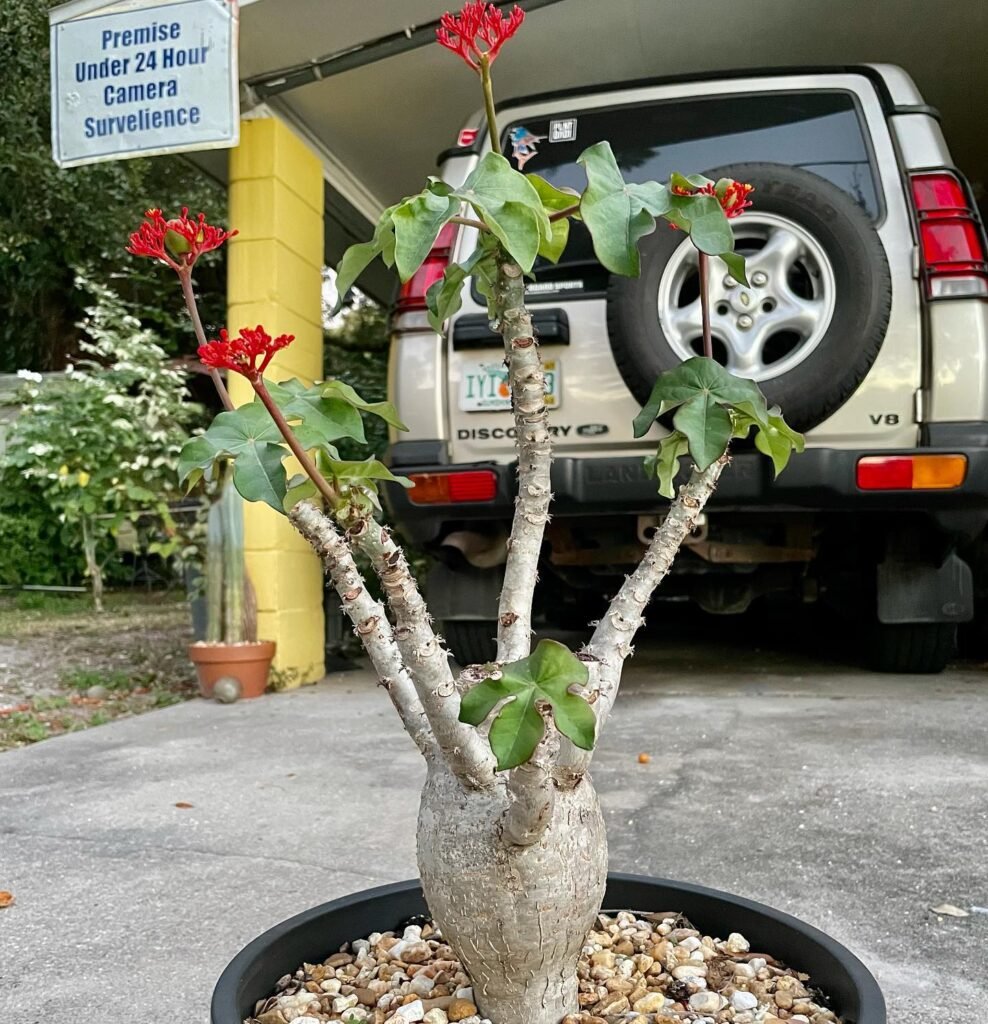
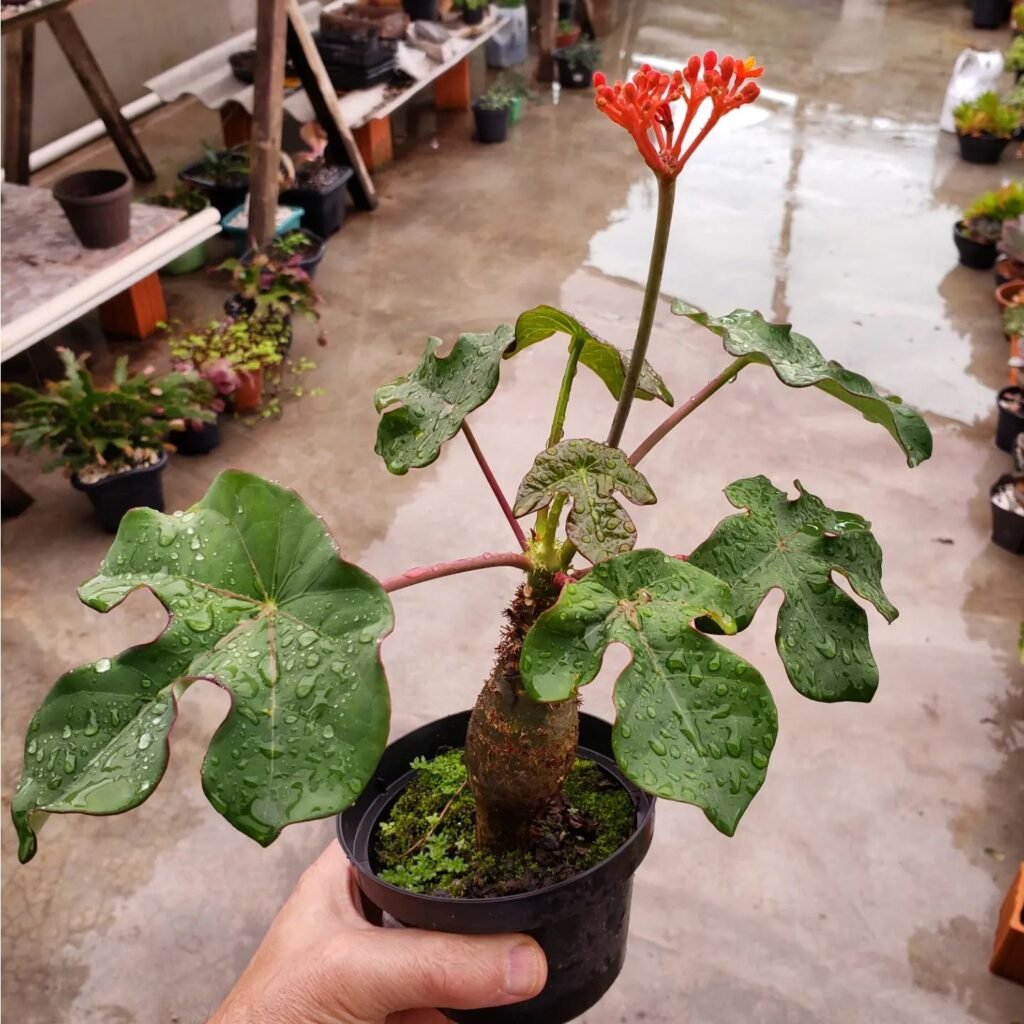
Jatropha podagrica, also known as the Buddha Belly Plant, is a captivating succulent plant that hails from the tropical regions of Central Americas. This ornamental plant showcases large green foliage and boasts a distinctive bottle-shaped trunk, giving it its unique nickname. With a maximum height of approximately 40cm and a spread of around 30cm, it can easily become a prominent feature in your garden.
When young, the leaves of the Jatropha podagrica exhibit a glossy and vibrant shade of green, gradually losing their sheen as they mature. What truly sets this plant apart is its stunning coral-red flowers, reminiscent of coral formations, which create a remarkable contrast against the lush green foliage. Its overall appearance adds an exotic touch of beauty to any garden, making it a must-have for succulent and caudex plant enthusiasts.
 Did you know the Jatropha podagrica, or Buddha Belly Plant, uses its swollen stem to store water, helping it survive droughts? This feature makes it a standout choice for water-wise gardens.
Did you know the Jatropha podagrica, or Buddha Belly Plant, uses its swollen stem to store water, helping it survive droughts? This feature makes it a standout choice for water-wise gardens.
Light Requirements for Jatropha podagrica
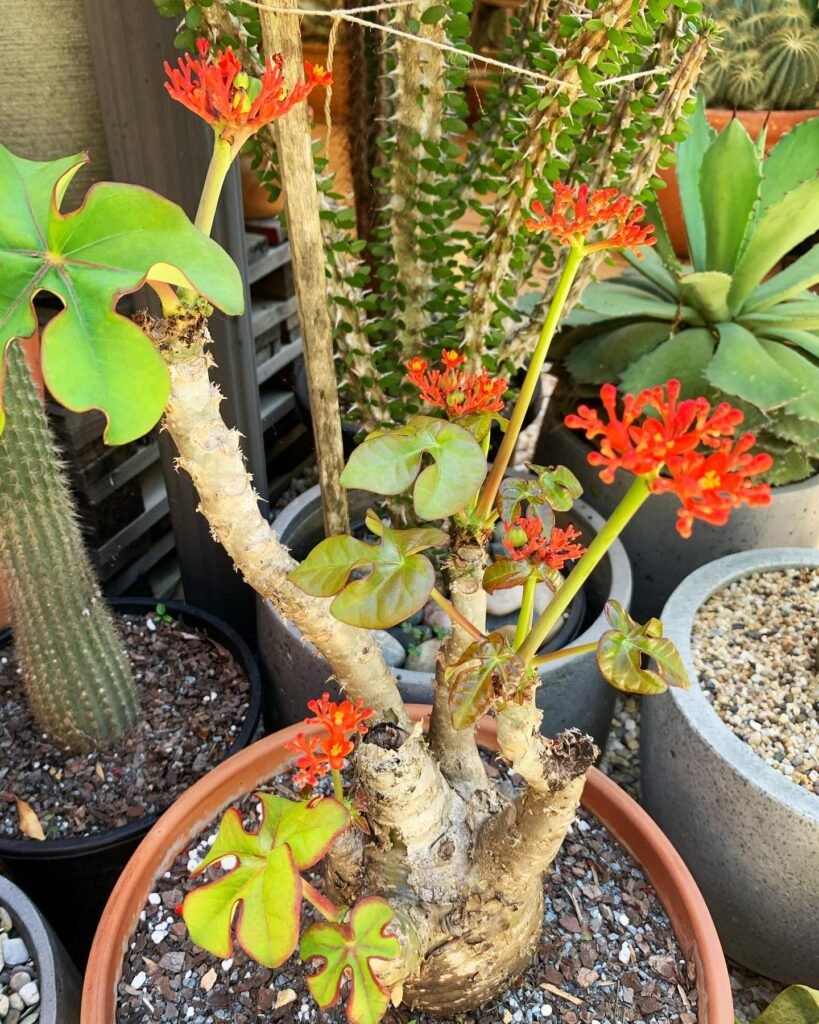

Jatropha podagrica, also known as the Buddha Belly Plant, thrives in bright light conditions. To keep this stunning succulent happy and healthy, it requires a bright, indirect location with the possibility of morning or evening sun.
- For optimal growth, place your Jatropha podagrica near a north, east, or west-facing window. Alternatively, a semi-shaded conservatory is an ideal spot.
- This plant can tolerate up to two hours of early morning or late evening sunlight in the spring and summer, and up to three hours in the autumn and winter.
- However, it’s crucial not to over-expose the plant to direct sunlight as it can cause sunburn and dehydration.
- Avoid deep shade, as it can lead to over-watering and the decline of the plant.

Watering Tips for Jatropha podagrica (Buddha Belly Plant)
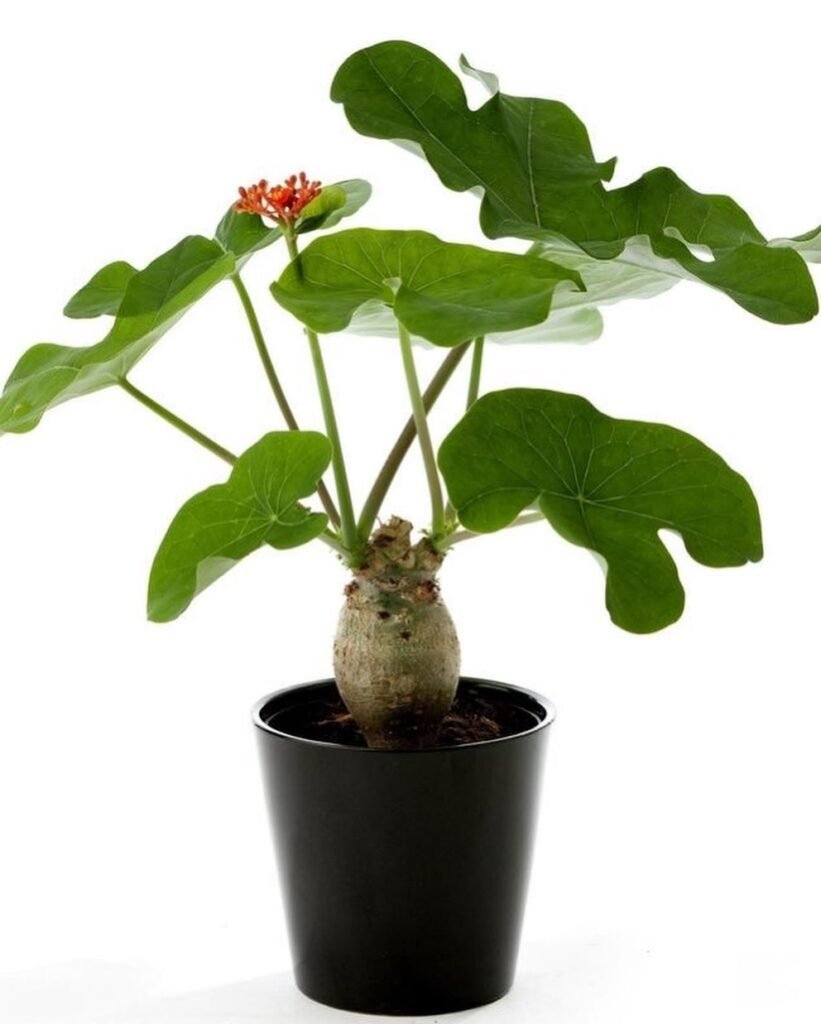

Jatropha podagrica, also known as the Buddha Belly Plant, is a drought-tolerant plant that prefers to be kept on the drier side. To ensure the health and vitality of your Jatropha podagrica, follow these watering tips:
- Allow the top third of the soil to dry out: It is important to let the soil dry out between waterings. Check the moisture level by inserting your finger into the soil up to the first knuckle. If it feels dry at this depth, it’s time to water your plant.
- Avoid over-watering: Over-watering can lead to root suffocation and root rot, which can be detrimental to your Jatropha podagrica. Make sure the soil is completely dry before watering again.
- Prevent under-watering: While Jatropha podagrica is drought-tolerant, it still requires regular watering to stay healthy. Wilting leaves and stunted growth are signs of under-watering. Adjust your watering schedule accordingly to meet the plant’s needs.
- Reduce watering frequency in autumn and winter: During the plant’s dormancy period in the cooler months, it is recommended to slightly reduce the frequency of waterings. This helps accommodate its natural growth cycle.
When watering your Jatropha podagrica, it is best to use lukewarm water to avoid shocking the plant’s root system. Finding the right balance of watering is crucial to the plant’s overall health and longevity. Remember, it’s better to underwater than overwater your Buddha Belly Plant, so monitor the soil and adjust your watering schedule accordingly.

Fertilizing and Soil for Jatropha podagrica


Jatropha podagrica, also known as the Buddha Belly Plant, benefits from regular fertilization to promote healthy growth. To provide the necessary nutrients for growth, I recommend using a ‘Houseplant’ or ‘Cactus’ labeled fertilizer. In the spring and summer, use the fertilizer every four waters, and reduce it to every six waters in the colder months.
When it comes to soil, Jatropha podagrica prefers a well-draining potting mix labeled for ‘Houseplants’. This will ensure that the plant’s roots have enough air circulation and prevent waterlogged soil. To give your plant enough space to grow and thrive, it’s best to repot it every three years in the spring using the next size up pot and fresh potting mix.
- Use a ‘Houseplant’ or ‘Cactus’ labeled fertilizer every four waters in spring and summer
- Reduce fertilization to every six waters in colder months
- Choose a well-draining potting mix labeled for ‘Houseplants’
- Repot the plant every three years in the spring using the next size up pot and fresh potting mix

Pruning and Maintenance for Buddha Belly Plant

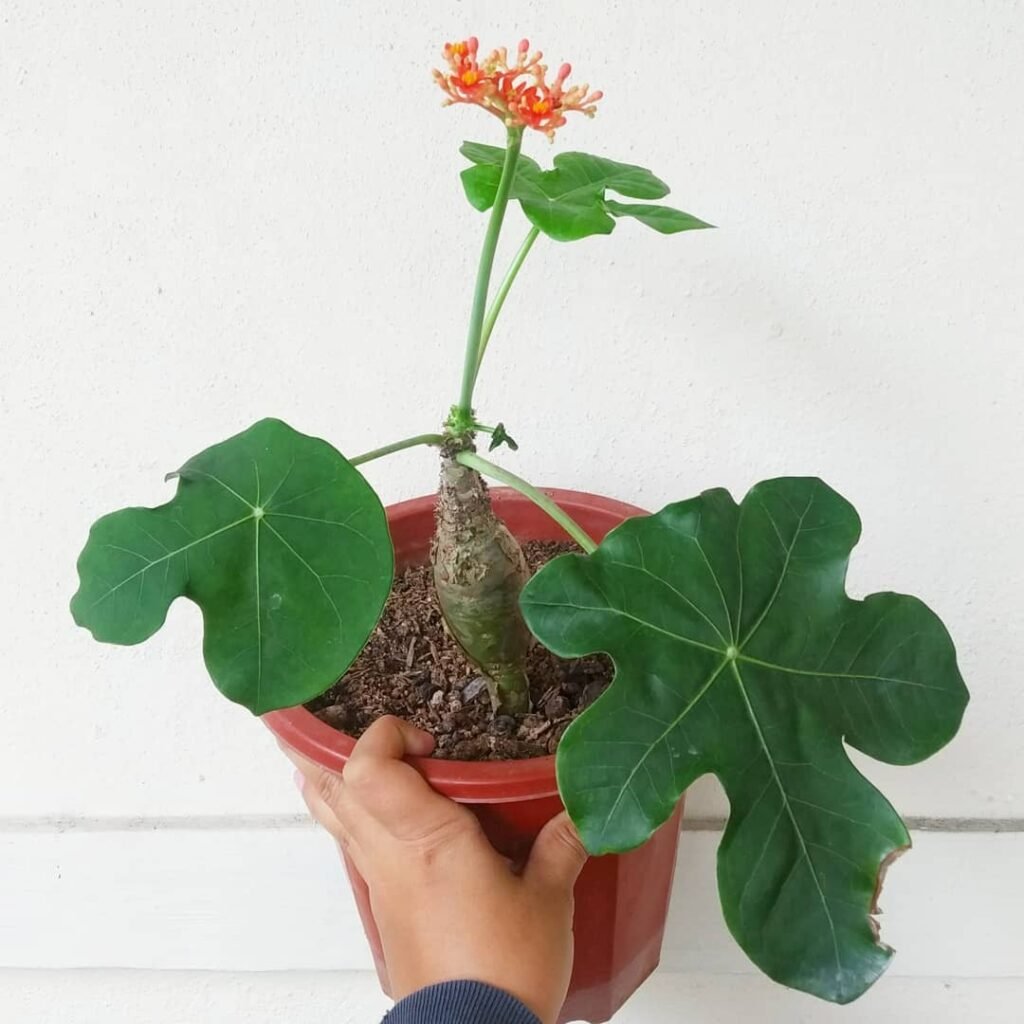
Pruning and maintenance are essential for ensuring the health and vitality of your Jatropha podagrica, also known as the Buddha Belly Plant. By following these practices, you can keep your plant looking its best and encourage optimal growth.
- Remove yellow or dying leaves: Regularly inspect your Buddha Belly Plant for any yellow or dying leaves. These leaves can hinder the overall health of the plant and should be promptly removed. Use clean scissors or shears to make clean incisions when pruning, as this helps reduce the risk of bacterial and fungal diseases.
- Clear plant debris: It’s important to keep the area around your Jatropha podagrica clean and free of plant debris. This helps create better-growing conditions and prevents the buildup of pests, diseases, and mold.
- Watch out for pests: Spider mites and mealybugs are common pests that can affect Buddha Belly Plants. Check the plant regularly, including its cubbyholes and the undersides of the leaves, for any signs of pest infestation. If you spot any pests, take immediate action to mitigate the problem using appropriate methods.

Propagating Jatropha podagrica (Buddha Belly Plant)
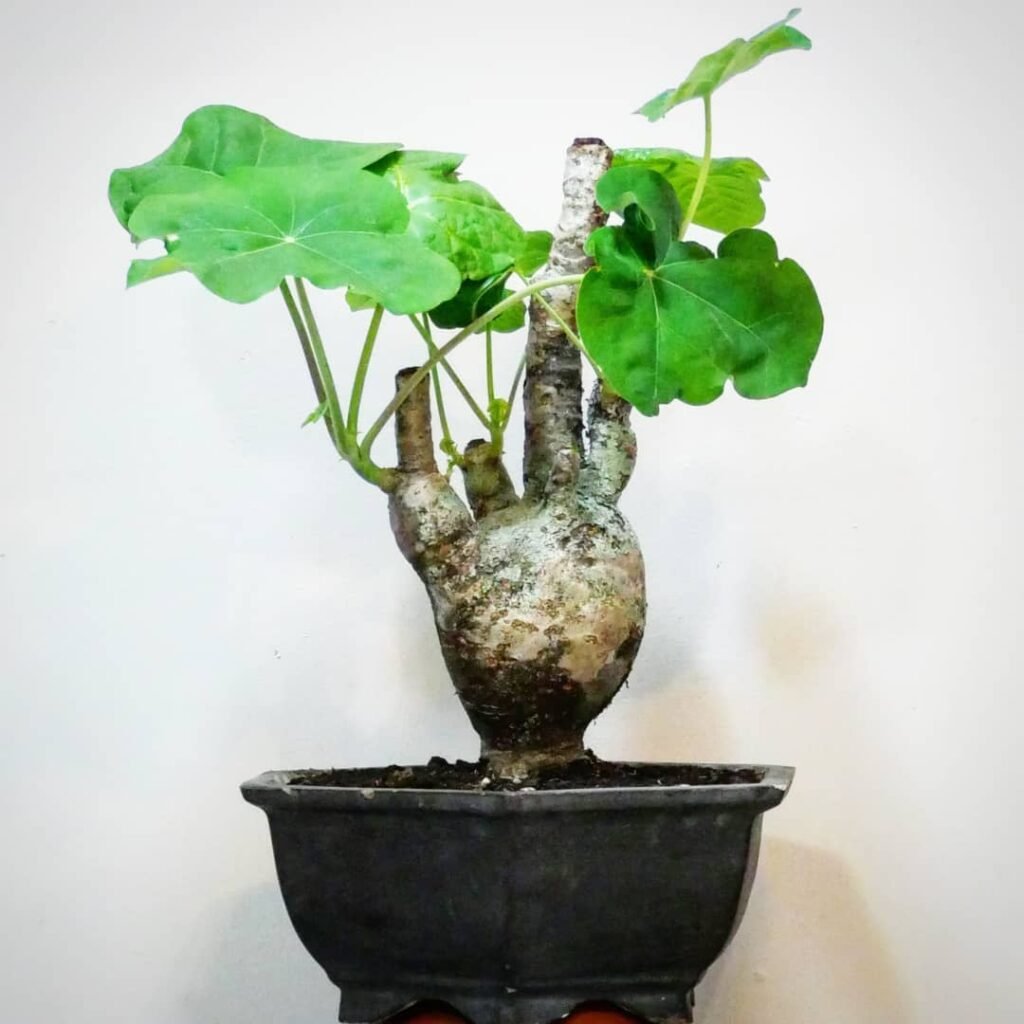
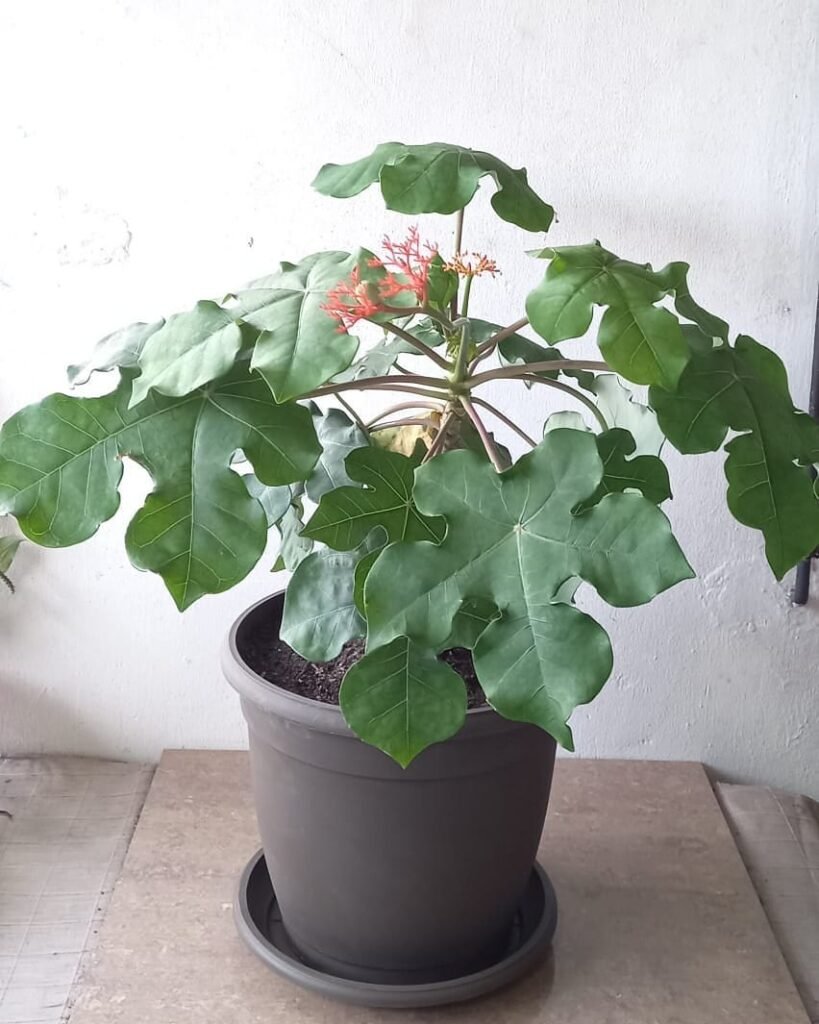
To propagate Jatropha podagrica, you can use stem cuttings. Start by selecting a healthy stem and carefully cut it just below a node. Remove the lower leaves from the cutting, leaving only a few at the top. This will help the cutting focus its energy on root development.
Dip the cut end of the stem in g to encourage root growth, then plant the cutting in a well-draining potting mix. It’s important to use a mix that allows water to drain freely, as Jatropha podagrica doesn’t tolerate soggy soil.
Keep the potting mix slightly moist, but not overly wet, as excessive moisture can lead to root rot. The roots will typically develop within a few weeks to a couple of months.
Once the roots are established, the new plant can be potted separately and treated as a mature Jatropha podagrica. This propagation method allows you to expand your collection of Buddha Belly Plants or share them with other plant enthusiasts.

Repotting Tips for Jatropha podagrica

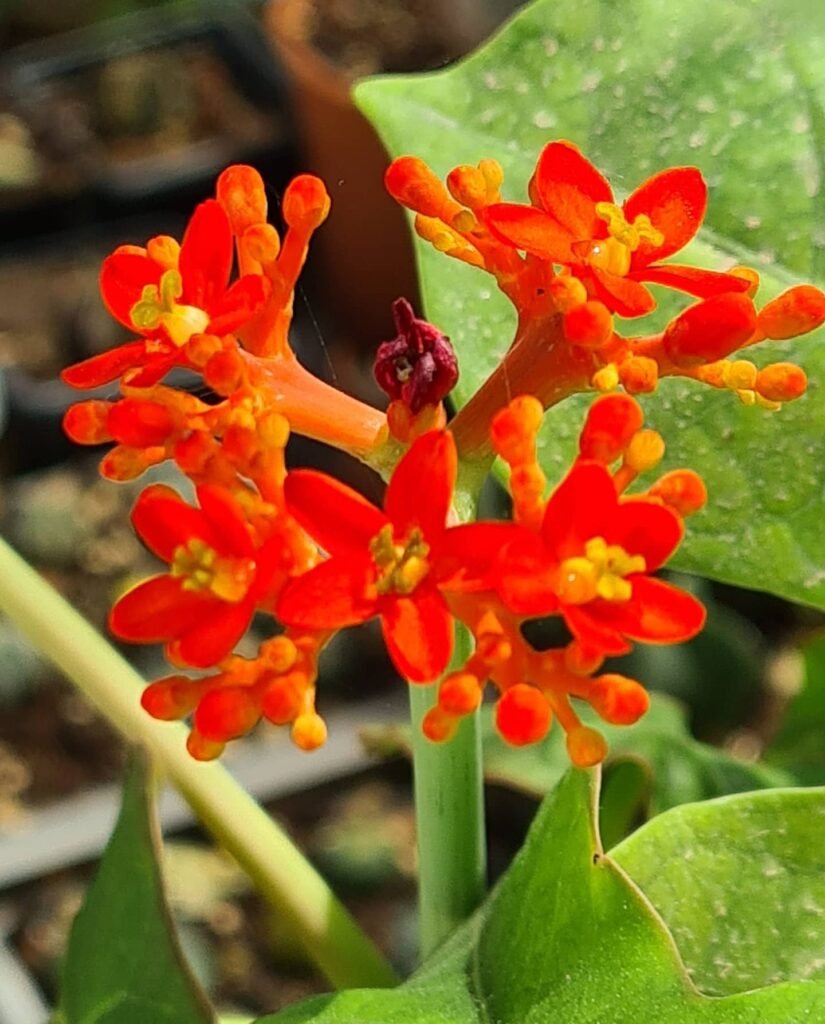
When it comes to caring for your Jatropha podagrica, repotting plays a crucial role in ensuring its growth and health. Here are some helpful tips to guide you through the repotting process:
- Timing: Repot your Jatropha podagrica every three years in the spring, allowing it to settle into its new pot during the active growing season.
- Pot Selection: Choose a pot that is one size larger than its current pot to provide ample space for the plant’s growth. A larger pot will also improve its overall stability.
- Potting Mix: Opt for a well-draining potting mix that is specifically labeled for ‘Houseplants’. This will ensure proper drainage and prevent waterlogging, which can be detrimental to the plant’s roots.
- Drainage Holes: Ensure that the new pot has drainage holes at the bottom to allow excess water to escape. This will prevent water accumulation, which can lead to root rot.
- Root Care: When repotting, gently loosen the roots of your Jatropha podagrica and remove any excess soil or old roots. This will create space for new growth and improve the plant’s overall health.
- Plant Placement: Place the Jatropha podagrica in the center of the new pot, ensuring that it is positioned upright. This will provide stability and balance as the plant continues to grow.
- Fresh Potting Mix: Fill in the gaps around the plant with fresh potting mix, ensuring that the roots are adequately covered. Lightly press the soil to secure the plant in its new pot.
- Light Watering: After repotting, give your Jatropha podagrica a light watering to help it settle into its new environment. Be cautious not to over-water, as this can cause root rot.
 Did you know the Jatropha podagrica blooms in vibrant colors, contrasting with its thick leaves? Its toxic sap, while hazardous, is researched for potential medicinal uses, including fighting cancer.
Did you know the Jatropha podagrica blooms in vibrant colors, contrasting with its thick leaves? Its toxic sap, while hazardous, is researched for potential medicinal uses, including fighting cancer.
Helpful Videos about Jatropha podagrica (Buddha Belly Plant)
Have a look at these exceptional videos I’ve discovered, all about nurturing Jatropha podagrica, often known as the Buddha Belly Plant. They’re filled with guidance to make looking after this distinctive plant straightforward, turning gardening into an enjoyable venture. Perfect for anyone looking to begin their journey in gardening!
FAQ about Jatropha podagrica (Buddha Belly Plant)

Curious about the optimal care for your Jatropha podagrica (Buddha Belly Plant)? You’ve landed in just the right place! I’ve compiled all the crucial questions to assist you in nurturing your plant effortlessly. Whether it’s perfecting the watering routine or tackling typical challenges, rest assured, you’re in knowledgeable hands.
Jatropha podagrica, often called the Buddha Belly Plant, is a tropical, succulent shrub known for its swollen, bottle-shaped trunk and bright green, lobed leaves. It produces small, red-orange flowers that add a splash of colour to your garden or indoor space.
It thrives in bright, indirect light. A spot near a south-facing window or a lightly shaded part of your garden is ideal. Direct sunlight can scorch the leaves, so provide some afternoon shade if possible.
Water when the top inch of soil feels dry to the touch. Over-watering can lead to root rot, so ensure the pot has good drainage. In winter, reduce watering as the plant enters a dormant period.
Yes, but sparingly. Feed with a balanced, water-soluble fertilizer every 4-6 weeks during the growing season (spring to summer). Avoid fertilizing in winter.
Repot in the spring, using a well-draining potting mix. Choose a pot only slightly larger than the current one, as a too-large pot can lead to waterlogged soil. Handle the plant carefully to avoid damage to its trunk and roots.
Yes, but as it’s a tropical plant, it needs protection from cold temperatures. Keep it outdoors in the warmer months and bring it inside before the first frost. It can enjoy summer on a patio or balcony.
It prefers temperatures between 15°C and 25°C. Avoid exposing it to temperatures below 10°C, as cold can damage or kill the plant.
Propagate by seed or cuttings. For cuttings, use a sharp, clean knife to take a piece of stem, allow it to dry for a day, then plant in well-draining soil. Keep warm and moist until roots develop.
Leaf drop can be caused by over-watering, under-watering, or sudden temperature changes. Assess your care routine and adjust as necessary, ensuring consistent watering and temperature conditions.
Inspect regularly for signs of pests such as aphids or spider mites. If pests are found, treat the plant with a gentle insecticidal soap or neem oil, following the product’s instructions.
Yes, with enough light, it can produce small, red-orange flowers indoors, though it’s less likely than when grown outdoors in optimal conditions.
Pruning isn’t usually necessary, but you can remove dead or damaged leaves and branches to encourage healthy growth. Use clean, sharp scissors or pruners.
Yes, the plant is toxic if ingested, due to the presence of toxic compounds in its sap. Keep it away from pets and children.
Use a pot with adequate drainage holes to prevent water accumulation. Terracotta pots are great for moisture regulation.
Ensure it gets enough light and consider using a phosphorus-rich fertilizer during its growing season to encourage blooms.
Regularly inspect your plant when watering for any signs of disease, such as rot or mildew. Early detection is key to successful treatment.
If your bathroom is bright and well-ventilated, it can be a good spot, thanks to the higher humidity levels. However, ensure it gets enough light.
I hope this FAQ has clarified the care requirements for your Jatropha podagrica (Buddha Belly Plant). If you have additional questions, please don’t hesitate to drop them in the comments. I’m here to lend a hand. Remember, everyone starts as a novice in the world of gardening, and there’s always something new to uncover as you care for your leafy friend.
Conclusion
By following these care tips, UK gardeners can successfully grow and maintain Jatropha podagrica, also known as the Buddha Belly Plant. This unique and striking succulent plant adds a touch of tropical beauty to any garden with its swollen stem and coral-red flowers.
When caring for Jatropha podagrica, it is important to provide the plant with the right amount of light. Choose a bright, indirect location and avoid exposing it to direct sunlight for extended periods. Additionally, water the plant appropriately by allowing the top third of the soil to dry out between waterings. Avoid over-watering to prevent root rot.
Fertilizing regularly with a suitable ‘Houseplant’ or ‘Cactus’ labeled fertilizer will help promote healthy growth. Prune the plant to remove any yellow or dying leaves, and keep an eye out for pests such as spider mites and mealybugs. Propagate Jatropha podagrica through stem cuttings and repot the plant every three years in a well-draining potting mix labeled for ‘Houseplants’.
With proper care and attention, your Jatropha podagrica will thrive and become a standout feature in your garden. Enjoy the beauty and uniqueness of this fascinating plant!

